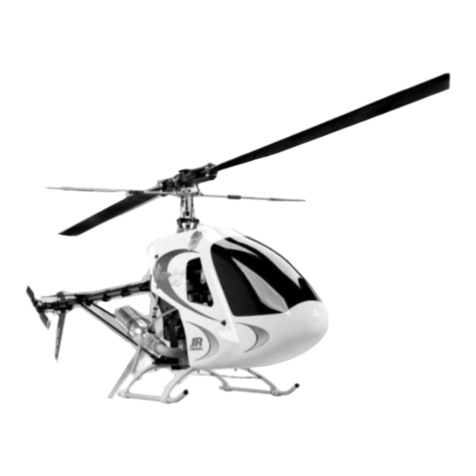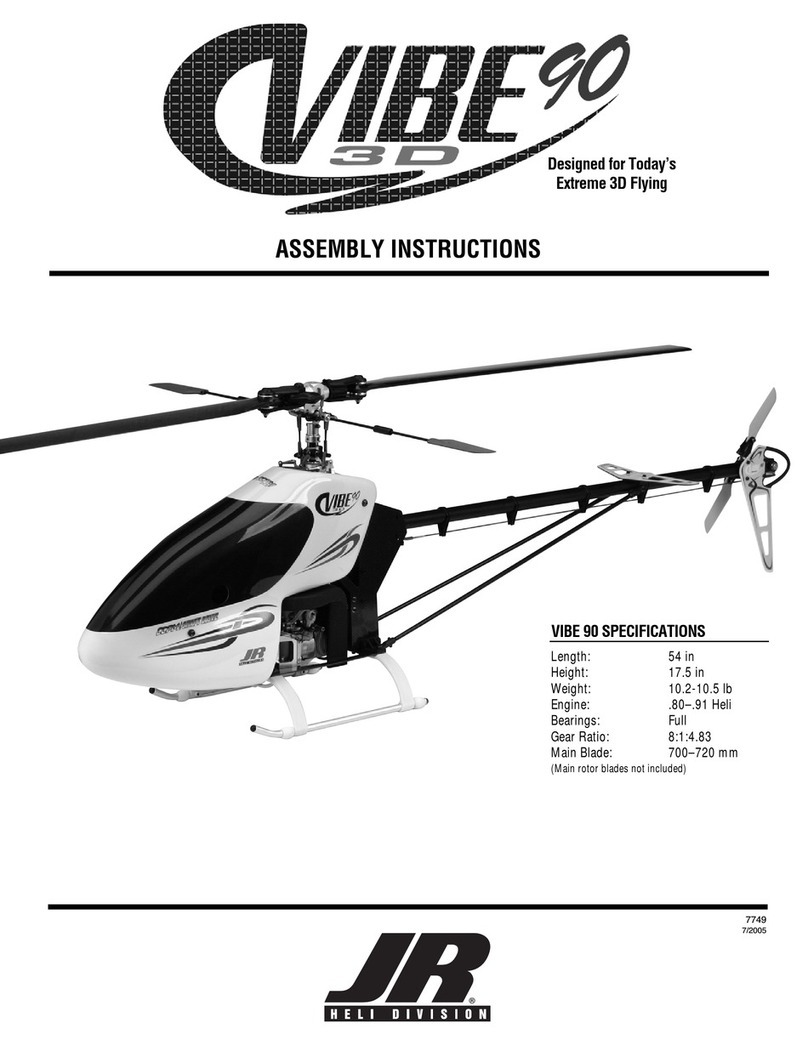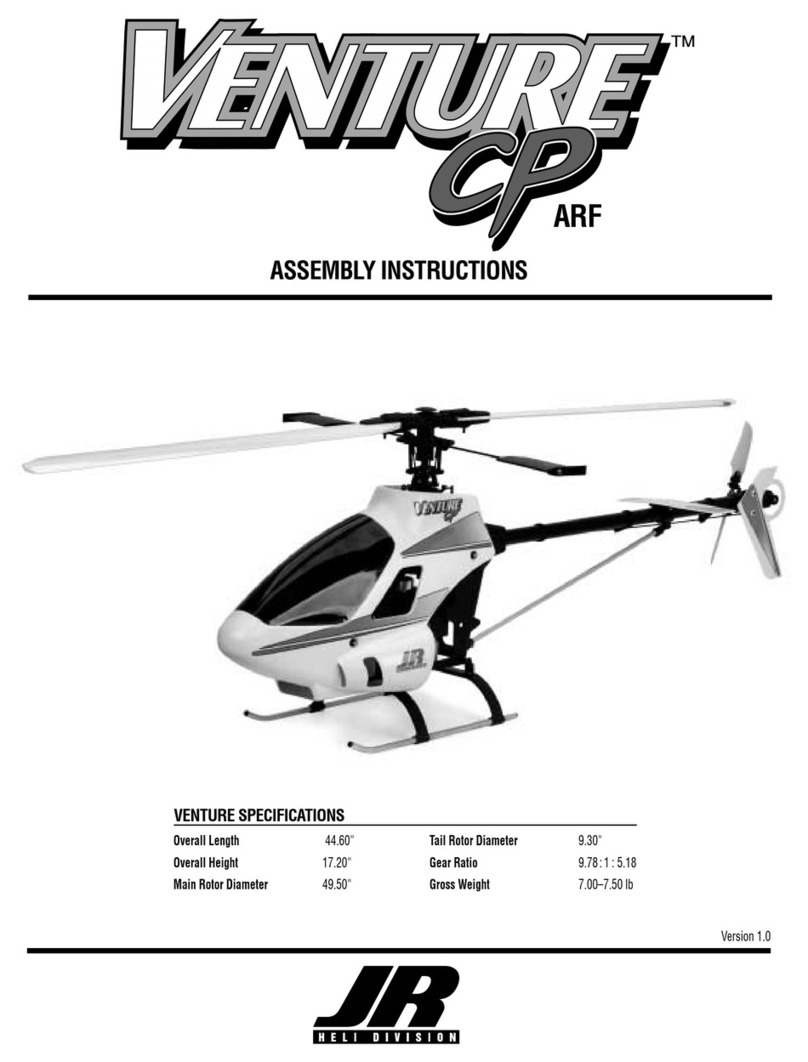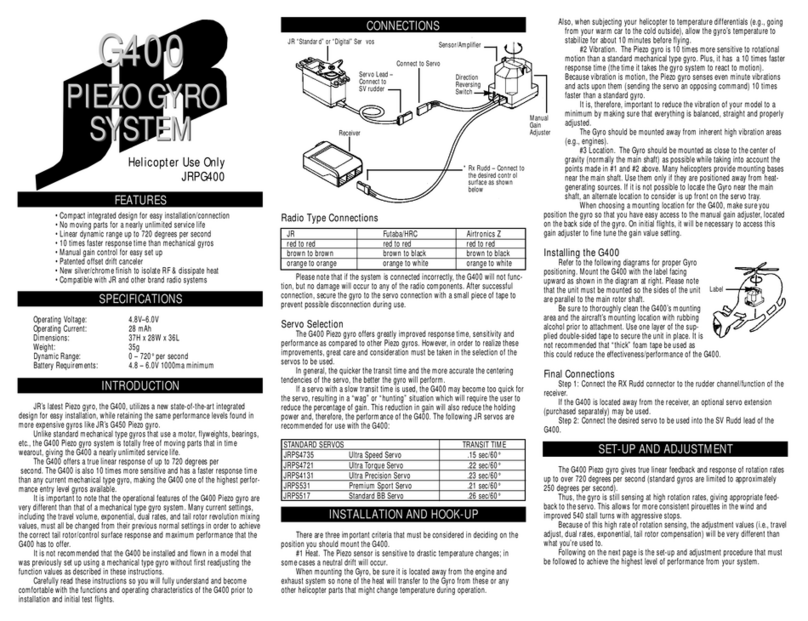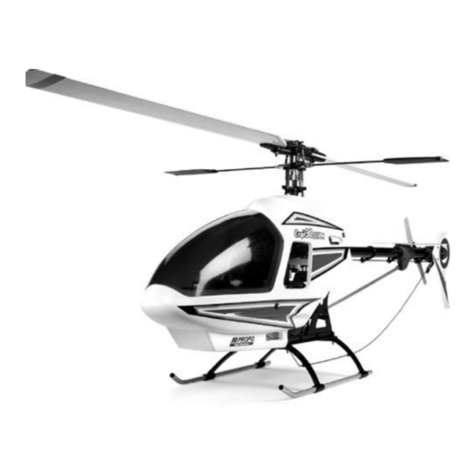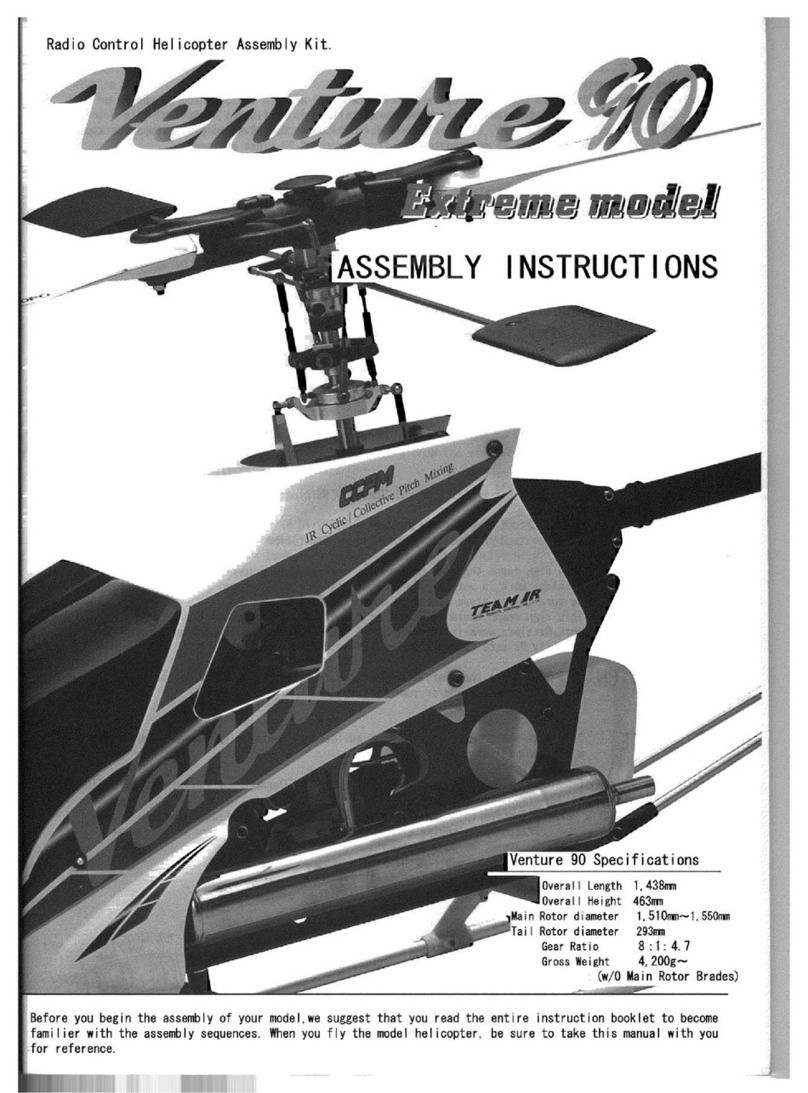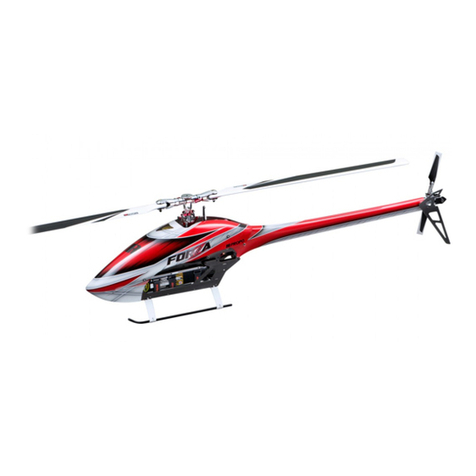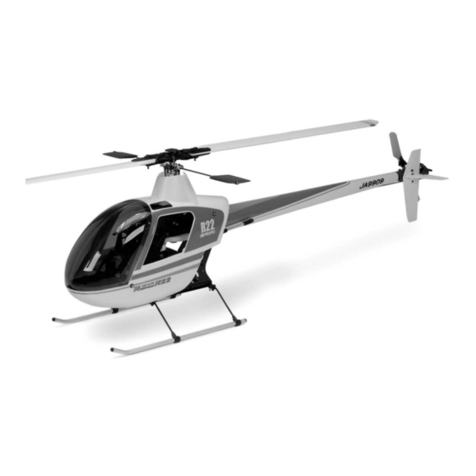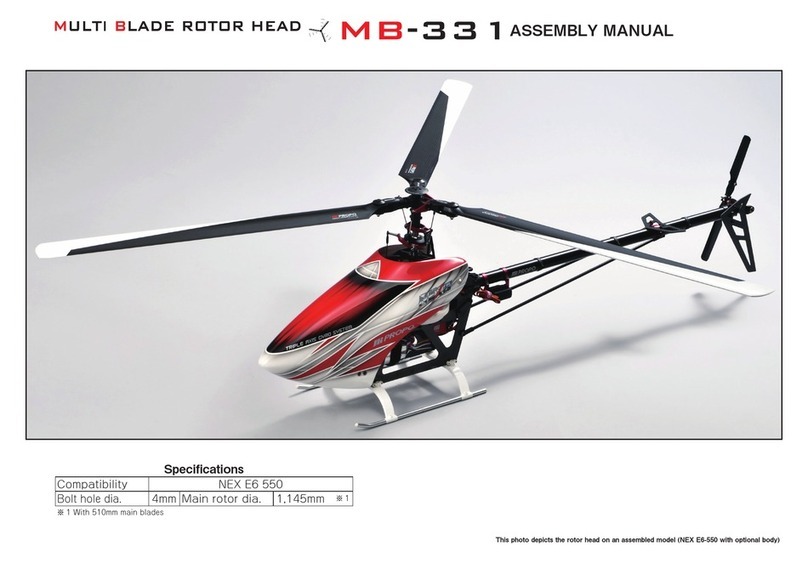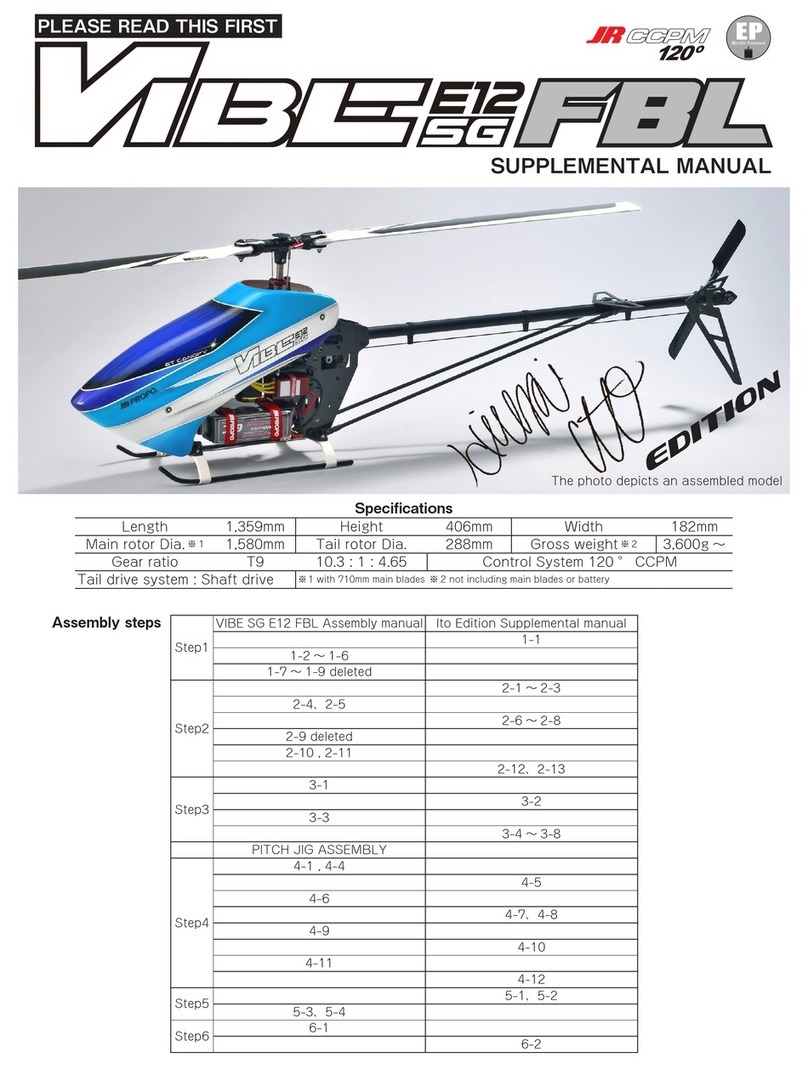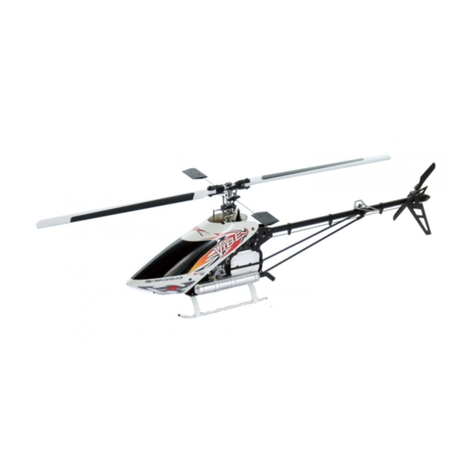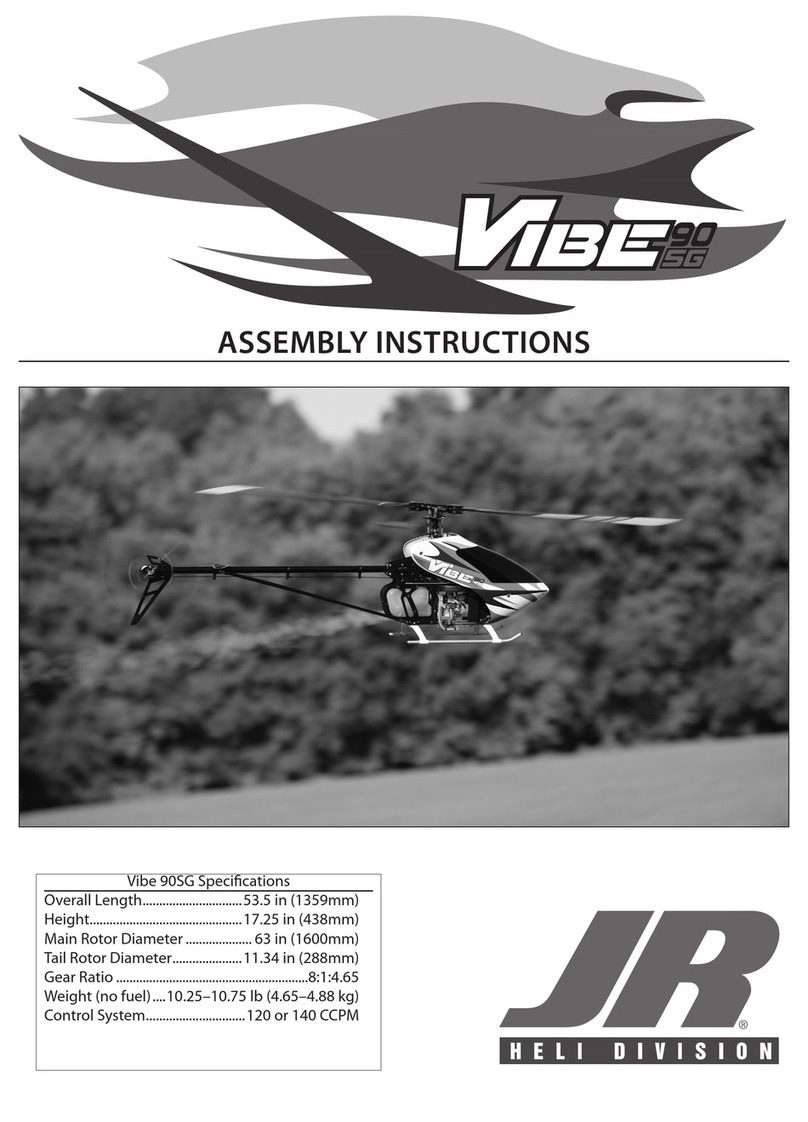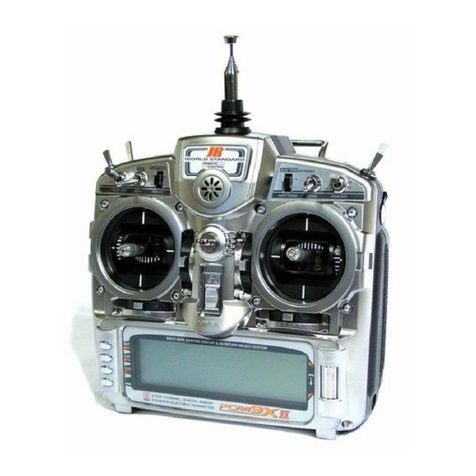CONFIRMING GYRO/SERVO DIRECTION
INITIAL TRANSMITTER SETTINGS
Step 1: Be sure the rudder servo is moving in the proper
direction. A right rudder command should move the nose
to the right (if you’re unsure, seek help from someone more
experienced). Reverse the servo direction in the transmitter
if necessary.
Step 2: Give a right rudder command and note the
direction the rudder servo moves (clockwise or counter-
clockwise). Now pick up the helicopter and quickly move the
nose to the left. The servo should move in the same direction
as a right rudder command. If it moves in the opposite
direction, switch the small reverse switch located on the
G500T gyro in the opposite direction.
Important: When the reversing switch on the gyro is
changed, this will also reverse the direction of the tail
servo. If the gyro reversing switch is changed, it will be
necessary to reverse the direction of the servo using the
transmitter’s servo reversing function.
Right Rudder Command
(tail blades pitch left)
Right Rudder Command
(nose moves right)
SERVO TRAVEL - LIMITER POT 3-YEAR WARRANTY COVERAGE
Your new equipment is warranted to the original purchaser
against manufacturer defects in material and workmanship for 3
years from the date of purchase. During this period, Horizon
Service Center will repair or replace, at our discretion, any
component that is found to be factory defective at no cost to
the purchaser. This warranty is limited to the original purchaser
of the unit and is not transferable.
This warranty does not apply to any unit which has been
improperly installed, mishandled, abused, or damaged in a
crash, or to any unit which has been repaired or altered by any
unauthorized agencies. Under no circumstances will the buyer
be entitled to consequential or incidental damages.
This limited warranty gives you specific legal rights; you also
have other rights which may vary from state to state.
As with all fine electronic equipment, do not subject your
unit to extreme temperatures, humidity or moisture. Do not
leave it in direct sunlight for long periods of time.
Warranty Repair
To receive warranty service, you must include a legible
photocopy of your original dated sales receipt to verify your
proof-of-purchase date. Providing that warranty conditions have
been met, your equipment will be repaired without charge.
Normal Non-Warranty Repairs
Should your repair cost exceed 50% of the retail purchase
cost, you will be provided with an estimate advising you of your
options.
Within your letter, advise us of the payment method you
prefer to use. Horizon Service Center accepts VISA or
MasterCard. Please include your card number and expiration
date. Mail your system to:
Horizon Service Center
4105 Fieldstone Road
Champaign, Illinois 61822
(217) 355-9511
www.horizonhobby.com
REPAIR SERVICE INSTRUCTIONS
CONTROL ROD/ARM ADJUSTMENT
Following is the setup and adjustment procedure that must
be followed to achieve the highest level of performance
from your system.
Step 1: Set the G500T to the Rate Mode position as
described above.
Step 2: Unhook the control linkage from your servo and swing
the servo arm out of the way. Lightly grasp the pushrod at the
servo end and run the linkage through its entire travel. The
linkage should move through its entire range smoothly with
very little friction and no rough spots. Work on the linkage
system until this is achieved.
Step 3: On your transmitter, set all trimmers (sub-trim, trim
offset, mechanical trim, etc.) to zero. For heli, set the
throttle/pitch stick at exactly the hover position (standard hover
position is 50%). Turn off or zero out both the revolution
mixing up and down and the acceleration mixing.
Step 4: Turn on your receiver and allow the model to remain
totally motionless for 3 seconds. This procedure is necessary
to allow the G500T time to establish and record the center or
neutral positions.
Step 5: Remove the servo arm and replace it so that it is
exactly 90° to the tail rotor pushrod (see diagram). You may
find that the spline in the servo output shaft are just offset
enough on your servo arm so as to not allow 90° positioning.
Rotate the servo arm to another arm and try again. Find
the arm that is closest to 90° and secure it in place with
the provided screw.
Trimming Neutral with Sub-Trim
When in tail lock mode, the servo arm may "creep" or move
slightly. This movement is normal, and can be corrected by
changing the sub trim value in your radio system for the
rudder channel. Enter the sub-trim function of your system
and add a left or right value for the rudder channel. Re-center
the rudder servo with the control stick and re-test. Add/reduce
sub trim as needed until the servo will remain motionless,
and in the neutral position. A value of 6-8 is generally all
that is required for this final trimming.
After some experience and flight time is gained, these values
can be adjusted to suit your preference. Use these values as a
starting point.
• Travel Adjust
Left Rudder 150%
Right Rudder 150%
• Dual Rates
Hover Mode/Low Rate 80%
Stunt Mode/High Rate 100%
• Exponential Values
Hover Mode/Low Rate 30% 20%
Stunt Mode/High Rate 40% 30%
• Gyro Gain Values
Hover Mode/High Rate 90% 75%
Stunt Mode/Low Rate 75% 0-65%
• Revolution Mixing
Hover Mode 5%L 5%R
(Rate Mode/Heli Only) Stunt Mode 5%L 5%R
The G500T features a manual servo travel limiter located on
the side of the gyro as shown in the diagram. This manual
setting allows you to use a full 150% travel value in your radio
setup for the best resolution, while being able to reduce the
physical travel of the servo to remove any tail linkage binding.
The travel adjustment pot increases or decreases the travel
of the servo in both directions equally.
To set the physical travel of the servo, move the servo via
the transmitter stick to its extreme Left/Right positions while
looking at the tail pitch control slider on the back of the model.
If there is visible clearance at maximum travel in each direction,
increase the servo travel with the limiter pot. If binding is
occurring in one or both directions, reduce the travel limit pot
as needed until binding is removed.
Note: If it is necessary to reduce gain values below this level
to stop hunting, move the servo arm ball in one hole
towards the ceenter of the on the servo arm and re-test.
Reducing the gain below these recommended settings can
cause a reduction in gyro gain holding power and overall
gyro performance.
GYRO GAIN SELECTION
Remote Gyro Gain Access Options
JR PCM 10 Series Systems: Connect to Aux 3 Channel
If you are using a PCM-10, 10S, 10SX, 10SxII or 10X and
would like to make use of the Code 44 gyro sensitivity
adjustment feature, you will need to enter code 44 and activate
this function. If code 44 is not activated, then the gain
adjustment would be made through the servo travel adjust
function for the Aux 3 channel.
JR XP8103 and X-378 Systems: Connect to Aux 2 Channel
If you are using any version if the JR XP8103 or X-378 and
would like to make use of the gyro sensitivity adjustment
feature, you will need to enter the function mode and activate
the Gyro Sens function. If Gyro Sens is not activated, then the
gain adjustment would be made through the servo travel adjust
function for the Aux 2 channel.
JR XP662 Systems: Connect to Gear Channel
The the gain adjustment will be accessed through the servo
travel adjust function for the Gear channel.






